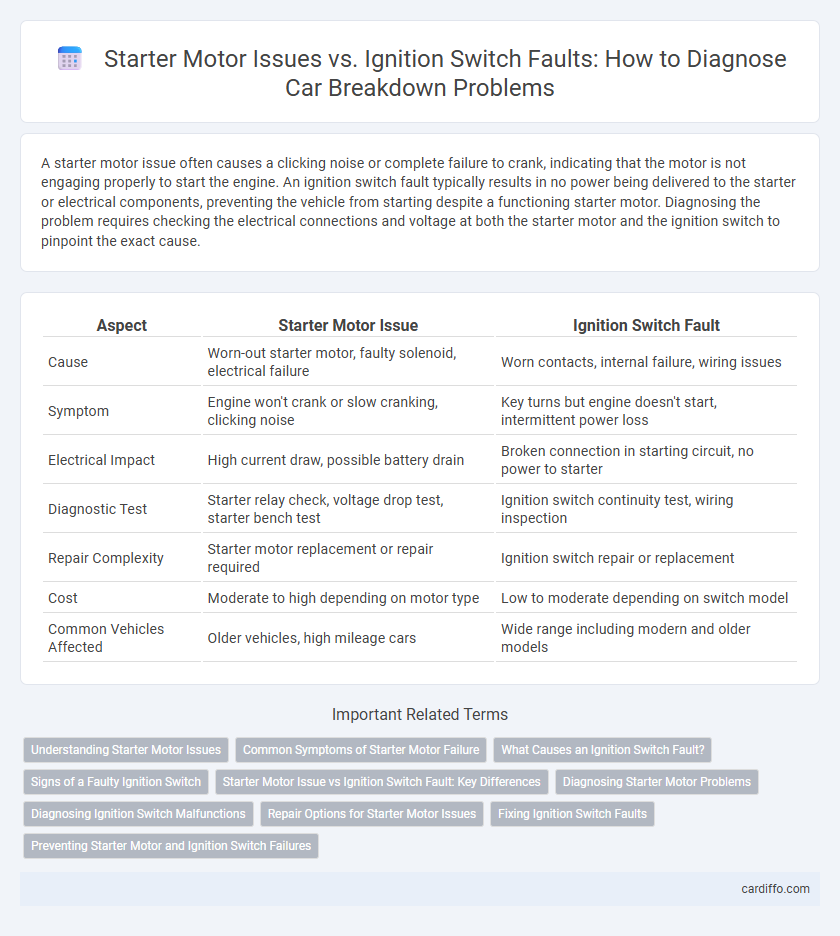A starter motor issue often causes a clicking noise or complete failure to crank, indicating that the motor is not engaging properly to start the engine. An ignition switch fault typically results in no power being delivered to the starter or electrical components, preventing the vehicle from starting despite a functioning starter motor. Diagnosing the problem requires checking the electrical connections and voltage at both the starter motor and the ignition switch to pinpoint the exact cause.
Table of Comparison
| Aspect | Starter Motor Issue | Ignition Switch Fault |
|---|---|---|
| Cause | Worn-out starter motor, faulty solenoid, electrical failure | Worn contacts, internal failure, wiring issues |
| Symptom | Engine won't crank or slow cranking, clicking noise | Key turns but engine doesn't start, intermittent power loss |
| Electrical Impact | High current draw, possible battery drain | Broken connection in starting circuit, no power to starter |
| Diagnostic Test | Starter relay check, voltage drop test, starter bench test | Ignition switch continuity test, wiring inspection |
| Repair Complexity | Starter motor replacement or repair required | Ignition switch repair or replacement |
| Cost | Moderate to high depending on motor type | Low to moderate depending on switch model |
| Common Vehicles Affected | Older vehicles, high mileage cars | Wide range including modern and older models |
Understanding Starter Motor Issues
Starter motor issues often manifest as a clicking sound or complete engine failure to crank, indicating electrical or mechanical faults within the motor itself. Ignition switch faults typically result in intermittent power loss or failure to send the start signal, differentiating the problem from starter motor malfunction. Diagnosing starter motor issues requires testing voltage at the motor terminals and checking for worn brushes or solenoid failure to ensure accurate identification and timely repair.
Common Symptoms of Starter Motor Failure
Common symptoms of starter motor failure include a clicking noise when turning the ignition key, a completely silent response despite a fully charged battery, and the engine failing to crank. In contrast, ignition switch faults often cause intermittent electrical issues such as dashboard lights flickering or accessories not powering on. Diagnosing starter motor issues accurately requires checking for voltage at the motor and inspecting for worn-out brushes or solenoid malfunctions.
What Causes an Ignition Switch Fault?
Ignition switch faults are commonly caused by worn-out internal electrical contacts, leading to inconsistent power delivery to the starter motor. Corrosion, dirt buildup, or poor wiring connections within the ignition switch can disrupt the signal required to engage the starter motor. Unlike starter motor issues, which stem from mechanical failure or dead batteries, ignition switch faults originate from electrical malfunctions affecting vehicle startup.
Signs of a Faulty Ignition Switch
Signs of a faulty ignition switch include intermittent power loss to the dashboard and accessories, the engine failing to start despite a fully charged battery, and stalling while driving due to disrupted electrical flow. Unlike a starter motor issue that typically produces a single clicking noise or no crank at all, ignition switch problems often cause fluctuating electrical components and inconsistent engine behavior. Diagnosing ignition switch faults involves checking for worn contacts or corrosion within the switch that interrupts the circuit essential for proper starting and running.
Starter Motor Issue vs Ignition Switch Fault: Key Differences
A starter motor issue typically results in a clicking sound or complete failure to crank the engine, indicating problems with the motor itself or its electrical connections. An ignition switch fault, however, often causes intermittent or no response when turning the key, as the switch fails to send power to the starter motor or other ignition components. Diagnosing between these faults involves checking battery voltage, starter relay function, and ignition switch continuity to pinpoint the exact malfunction.
Diagnosing Starter Motor Problems
Diagnosing starter motor problems involves checking for symptoms such as a clicking noise, slow engine crank, or complete lack of response when turning the key. Testing the battery voltage and verifying proper connection to the starter motor helps rule out electrical issues, while inspecting the starter solenoid and motor brushes identifies mechanical faults. Differentiating between starter motor failure and ignition switch fault requires using a multimeter to check voltage at the starter during ignition and observing if the engine fails to crank despite a functioning ignition switch.
Diagnosing Ignition Switch Malfunctions
Diagnosing ignition switch malfunctions begins with checking for inconsistent or no power to the starter motor despite a functional battery and starter. Testing voltage at the ignition switch terminals reveals if it reliably sends the signal to the starter relay during key turn. Faulty ignition switches often cause intermittent starter engagement without signs of a dead starter motor or battery issues.
Repair Options for Starter Motor Issues
Starter motor issues often require targeted repair options such as replacing worn brushes, rebuilding the starter solenoid, or installing a new starter assembly to restore reliable engine cranking. Diagnostic testing with a multimeter can pinpoint electrical faults causing starter malfunction, ensuring accurate repair solutions. Timely repair prevents complete starter failure, avoiding more costly towing and roadside service during breakdowns.
Fixing Ignition Switch Faults
Fixing ignition switch faults involves diagnosing electrical connectivity problems that prevent the engine from starting despite the starter motor functioning correctly. Repairing or replacing the faulty ignition switch restores proper power flow to the starter system and dashboard electronics, eliminating intermittent startup failures. Professional troubleshooting tools can pinpoint ignition switch defects, ensuring accurate repairs and reliable vehicle ignition performance.
Preventing Starter Motor and Ignition Switch Failures
Regular maintenance of the starter motor, including checking electrical connections and battery health, is crucial to prevent starter failures. Inspecting and cleaning the ignition switch contacts can reduce wear and avoid intermittent faults that mimic starter motor problems. Using high-quality components and avoiding excessive force on ignition keys also extend the lifespan of both the starter motor and ignition switch.
Starter motor issue vs ignition switch fault Infographic

 cardiffo.com
cardiffo.com